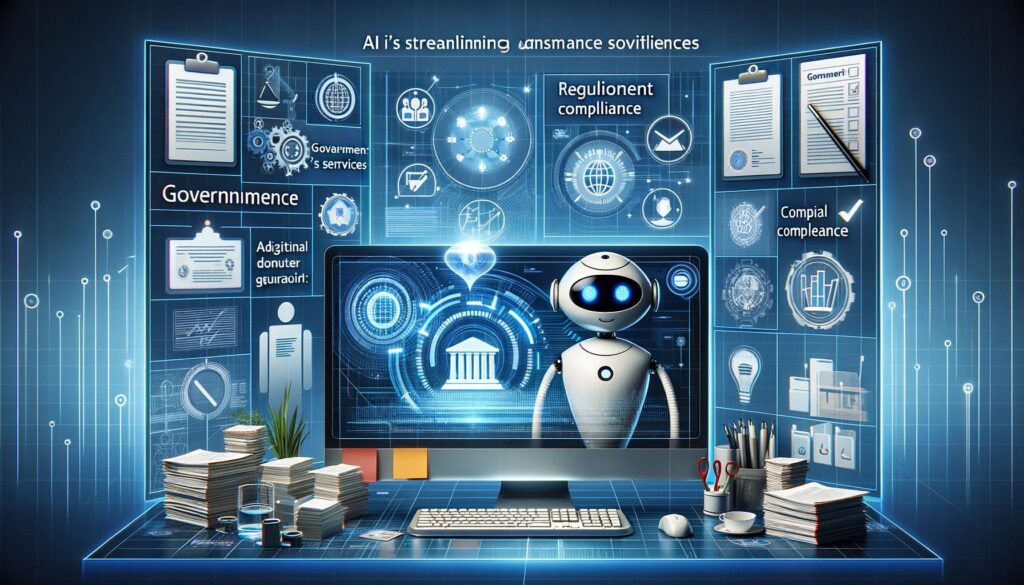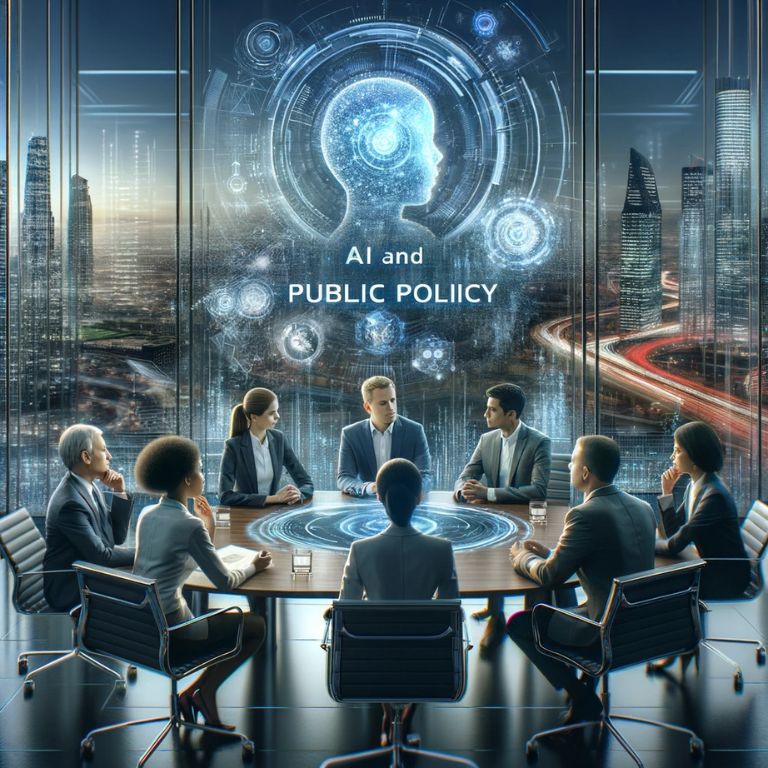Artificial Intelligence (AI) is revolutionizing every facet of our lives, and its influence extends far beyond technological realms. It is making a profound impact on public policy and the regulatory landscape. In this article, we embark on a journey to investigate how AI is shaping the future of regulations and policy-making. We will delve into the dynamic intersection where advanced technology meets governance and explore the implications, challenges, and opportunities that arise from this synergy.
The Increasing Role of AI in Public Policy
The integration of AI into public policy processes is becoming increasingly prevalent. AI, with its ability to analyze vast datasets, predict outcomes, and automate decision-making, offers policymakers powerful tools to enhance the formulation and execution of policies. From healthcare and transportation to education and environmental regulation, AI is leaving its mark on every sector.
Understanding the Significance
Understanding the significance of AI’s role in public policy is paramount. As governments and regulatory bodies navigate the complexities of an increasingly digital and data-driven world, AI offers solutions to long-standing challenges. These include more efficient resource allocation, improved risk assessment, and the ability to respond swiftly to emerging issues.
The Importance of this Exploration
This exploration is not merely an academic exercise. It’s a vital endeavor to ensure that AI technologies are harnessed responsibly for the betterment of society. By comprehending the intricate relationship between AI and public policy, we can shape regulations that safeguard individual rights, uphold ethical standards, and foster innovation.
The Intersection of AI and Public Policy
Exploring the Synergy
To comprehend the impact of AI on public policy, we must first explore the synergy between these two seemingly disparate realms. Artificial Intelligence, often referred to as AI, is a broad field of computer science that aims to create intelligent machines capable of simulating human-like cognitive functions such as learning, problem-solving, and decision-making. Public policy, on the other hand, encompasses the rules, regulations, and decisions made by governments and institutions to address societal issues.
The intersection of AI and public policy occurs when AI technologies are harnessed to inform, shape, or implement policy decisions. This intersection is characterized by several key dynamics:
Data-Driven Policy Analysis
AI’s ability to process and analyze vast amounts of data is invaluable for policymakers. Data-driven policy analysis enables governments to make informed decisions based on empirical evidence rather than intuition. For example, AI can analyze healthcare data to identify trends in disease outbreaks or assess the environmental impact of policy choices.
Predictive Modeling
AI’s predictive capabilities allow policymakers to anticipate future scenarios and their potential outcomes. This is particularly beneficial in areas such as economics, where AI models can forecast market trends, or in disaster management, where predictive models can help allocate resources efficiently during crises.
Automation of Decision-Making
Automation is a key aspect of AI that can streamline administrative processes. By automating routine decisions and tasks, public institutions can allocate their resources more effectively, reduce bureaucracy, and enhance the delivery of services to citizens.
Real-Time Monitoring and Feedback
AI technologies enable real-time monitoring and feedback mechanisms. For instance, AI-powered systems can monitor traffic flow and adjust transportation policies on the fly, or they can analyze social media sentiment to gauge public opinion on specific policy issues.
Historical Context
The integration of AI into public policy is not a recent development. Over the years, we have witnessed significant milestones that have paved the way for AI’s role in shaping regulations and policy-making. Some of these milestones include:
- Expert Systems: In the 1980s, expert systems were developed to emulate human expertise in specific domains, laying the groundwork for AI’s role in policy advice.
- Data Analytics: The proliferation of data in the 21st century made it imperative for governments to harness AI for data analysis, leading to data-driven policy decisions.
- Machine Learning: Advances in machine learning algorithms have empowered AI systems to learn from data and adapt, enabling more sophisticated policy modeling.
Understanding this historical context is essential to appreciate the evolution of AI’s role in public policy and the challenges and opportunities it presents. In the subsequent sections, we will delve deeper into these aspects, exploring ethical considerations, regulatory challenges, AI’s potential for policy innovation, and the future of AI in public policy.
AI in Policy Analysis and Decision-Making
Leveraging AI for Data-Driven Policy Analysis
One of the most profound impacts of artificial intelligence on public policy is its capacity to enhance data-driven policy analysis. AI systems are adept at processing vast datasets quickly and accurately, enabling policymakers to make informed decisions based on empirical evidence. Here are key aspects of how AI is revolutionizing policy analysis:
1. Efficient Data Processing
AI algorithms can sift through immense volumes of data, extracting relevant information and identifying patterns that human analysts may overlook. This efficiency is invaluable when dealing with complex policy issues that involve extensive data collection and analysis.
2. Predictive Analytics
Predictive analytics, powered by machine learning, enables policymakers to forecast the potential outcomes of different policy choices. For instance, in healthcare, AI models can predict disease trends, helping governments allocate resources for healthcare infrastructure and services accordingly.
3. Evidence-Based Decision-Making
AI promotes evidence-based decision-making by providing policymakers with a solid foundation of data. This approach ensures that policy decisions are grounded in empirical facts rather than political or ideological considerations, ultimately leading to more effective policies.
Automating Routine Decision-Making

Beyond data analysis, AI’s automation capabilities have a significant impact on policy decision-making. By automating routine and repetitive tasks, AI frees up human resources for more complex and strategic aspects of policymaking. Some examples include:
1. Administrative Efficiency
Government agencies can use AI-powered systems to automate administrative processes such as document verification, permit approvals, and data entry. This reduces bureaucratic bottlenecks and expedites service delivery to citizens.
2. Resource Allocation
AI can optimize the allocation of resources, whether it’s distributing funds to public programs or deploying emergency services during crises. Real-time data analysis ensures that resources are directed where they are needed most.
3. Risk Assessment
In financial regulation and cybersecurity, AI algorithms can assess risks and vulnerabilities in real-time, allowing regulators to respond swiftly to emerging threats and ensure compliance with regulations.
Enhancing Policy Analysis with AI Tools
To illustrate the practical use of AI in policy analysis, consider the following hypothetical scenario:
Scenario: Urban Traffic Management
Problem: A city faces increasing traffic congestion, leading to longer commute times, air pollution, and reduced quality of life for its residents.
AI Solution: Traffic management authorities deploy AI-based traffic monitoring systems equipped with cameras and sensors. These systems collect data on traffic patterns, vehicle counts, and congestion levels in real-time.
Benefits:
- Data-driven insights enable authorities to optimize traffic signal timings, reducing congestion.
- Predictive models anticipate traffic bottlenecks and enable proactive interventions.
- Automated traffic management adjusts to changing conditions, improving overall traffic flow.
As we can see, AI tools are instrumental in addressing complex policy challenges, such as urban traffic management, by providing data-driven solutions and automating decision-making processes.
Ethical Considerations
While the integration of Artificial Intelligence (AI) into public policy and decision-making brings about numerous benefits, it also raises significant ethical considerations. As AI becomes increasingly entrenched in the policymaking process, it is essential to address these ethical dilemmas and ensure that AI-powered policies align with societal values and principles.
Bias and Fairness
One of the most pressing ethical concerns in AI-driven policy is bias. AI algorithms learn from historical data, and if this data contains biases, the algorithms can perpetuate and even exacerbate those biases in policymaking. For example, if an AI system is used to assess job applications and it has been trained on biased historical hiring data, it may inadvertently discriminate against certain demographic groups.
To mitigate bias and promote fairness, policymakers must:
- Audit AI Algorithms: Regularly evaluate AI algorithms for bias and fairness, adjusting them as needed to eliminate discriminatory outcomes.
- Diverse Data Sources: Ensure that AI training data is diverse and representative of the entire population to reduce inherent biases.
Privacy Concerns
AI often involves the collection and analysis of vast amounts of personal data. This raises privacy concerns, as citizens may worry about their data being misused or exposed without consent. Policymakers must establish robust data protection regulations and mechanisms for informed consent to safeguard individual privacy rights.
Transparency and Accountability
The opacity of AI algorithms presents challenges for accountability and transparency. Citizens may not understand how AI decisions are made, making it difficult to hold policymakers accountable for AI-driven policies. To address this:
- Explainable AI: Promote the development of explainable AI models that provide transparency into the decision-making process.
- Algorithmic Audits: Mandate regular audits of AI algorithms used in policymaking to ensure accountability.
Job Displacement and Economic Impact
AI automation has the potential to displace certain jobs, causing economic upheaval in affected sectors. Policymakers must consider strategies to mitigate these effects, such as:
- Retraining and Upskilling: Implement programs to help workers transition to new roles or acquire skills relevant to emerging industries.
- Universal Basic Income (UBI): Explore the feasibility of UBI or similar social safety nets to provide financial stability during times of job displacement.
Accountability for AI Errors
When AI-driven policies fail or result in adverse consequences, determining responsibility can be challenging. Policymakers must establish frameworks for accountability, liability, and redress mechanisms for individuals harmed by AI-driven decisions.
International Collaboration
AI transcends national boundaries, and global cooperation is essential to establish common ethical standards and regulations. Policymakers should engage in international dialogues and collaborations to ensure AI-driven policies adhere to shared ethical principles.
In navigating these ethical considerations, policymakers can harness the benefits of AI while safeguarding individual rights, ensuring fairness, and maintaining public trust. Striking the right balance between technological advancement and ethical responsibility is paramount as we move forward in the AI-driven era of policymaking.
Regulatory Challenges and Adaptations
The integration of Artificial Intelligence (AI) into public policy presents both unique opportunities and formidable challenges for regulators. As AI technologies continue to evolve rapidly, regulatory bodies must adapt to ensure that AI-driven policies align with societal values, are ethically sound, and protect the rights of individuals.
The Pace of Technological Change
One of the primary challenges faced by regulators is the breakneck pace at which AI technologies advance. Traditional regulatory processes can be slow and cumbersome, struggling to keep up with the rapid development of AI. This lag between technological innovation and regulatory adaptation can lead to potential risks and missed opportunities.
To address this challenge:
- Agile Regulation: Implement agile regulatory frameworks that can be quickly adapted to address emerging AI developments.
- Continuous Monitoring: Establish mechanisms for ongoing monitoring and assessment of AI applications to identify and address potential risks promptly.
Cross-Industry Impact
AI is not confined to a single industry; its applications span across sectors, from healthcare and finance to transportation and education. Regulators must grapple with the complexity of AI’s cross-industry impact and ensure that policies are comprehensive and adaptable.
- Interdisciplinary Collaboration: Foster collaboration between regulatory bodies, industry experts, and academia to develop comprehensive AI regulations that consider the multifaceted nature of AI applications.
Data Privacy and Security

AI often relies on vast datasets, raising concerns about data privacy and security. Regulators must enforce stringent data protection measures and establish frameworks for secure data handling to mitigate potential breaches.
- Data Protection Regulations: Strengthen data protection regulations to ensure that personal data is handled responsibly and securely.
- Cybersecurity Standards: Enforce cybersecurity standards to safeguard AI systems against malicious attacks.
Ethical and Fair Use
Regulators must set guidelines to ensure the ethical and fair use of AI in policy. This includes preventing discriminatory practices, ensuring transparency, and promoting accountability.
- Ethical AI Frameworks: Develop and enforce ethical AI frameworks that prohibit biased or unfair AI decision-making.
- Transparency Requirements: Mandate transparency requirements for AI-driven policies, ensuring that citizens understand how decisions are made.
Public Engagement
Effective regulation requires public trust and engagement. Regulators must actively involve the public in the policymaking process and solicit their input to shape AI regulations.
- Public Consultations: Conduct public consultations and gather feedback on AI regulations to ensure that policies align with public values and concerns.
International Cooperation
AI knows no boundaries, making international collaboration crucial. Regulators should work together to harmonize AI regulations and ensure consistent global standards.
- International Agreements: Participate in international agreements and collaborations to establish common AI regulations and guidelines.
Navigating these regulatory challenges and adaptations is essential to harness the benefits of AI while mitigating potential risks. As AI continues to evolve, regulatory bodies must remain agile, interdisciplinary, and committed to upholding ethical standards in the ever-evolving landscape of AI-driven public policy.
AI’s Potential for Policy Innovation
The integration of Artificial Intelligence (AI) into public policy not only presents challenges but also unlocks a world of possibilities for innovation. AI-powered solutions have the potential to transform the way policies are formulated, executed, and monitored, leading to more efficient and effective governance.
Personalized Policy Solutions
AI can tailor policies to individual needs and circumstances. By analyzing vast datasets, AI systems can identify specific challenges faced by different segments of the population and recommend personalized policy interventions. For example:
- Education: AI can analyze students’ learning styles and aptitudes to suggest personalized educational programs, ensuring better learning outcomes.
- Healthcare: AI-driven healthcare policies can provide personalized treatment plans based on patients’ genetic makeup and medical history.
Predictive Policy Modeling
AI’s predictive capabilities enable policymakers to model the potential outcomes of various policy decisions accurately. This allows for more informed policy choices and the ability to anticipate and address emerging issues proactively.
- Economic Policy: AI models can forecast economic trends, helping governments make informed decisions on taxation, fiscal policies, and job creation.
- Environmental Policy: AI can predict the impact of climate change and recommend policies to mitigate its effects, such as sustainable energy initiatives and carbon reduction targets.
Efficient Resource Allocation
AI can optimize the allocation of resources by identifying areas of need and distributing resources accordingly. This efficiency is crucial for governments operating within budget constraints.
- Transportation: AI-powered traffic management systems can reduce congestion and improve the flow of traffic, minimizing infrastructure costs and reducing pollution.
- Social Services: AI can analyze social data to identify areas with higher poverty rates or educational needs, enabling targeted resource allocation.
Real-Time Monitoring and Adaptation
AI enables real-time monitoring of policy outcomes and the ability to adapt policies as circumstances change. For example:
- Public Safety: AI can analyze crime data to predict crime hotspots, allowing law enforcement to allocate resources more effectively.
- Public Health: During disease outbreaks, AI can track infection rates and recommend changes to containment strategies in real time.
Streamlining Administrative Processes

Administrative efficiency is a hallmark of AI-powered governance. By automating routine tasks and decision-making processes, governments can reduce bureaucracy and allocate human resources more strategically.
- Government Services: AI chatbots and virtual assistants can handle citizen inquiries and paperwork, improving the efficiency of government agencies.
- Regulatory Compliance: AI can streamline regulatory compliance processes, making it easier for businesses and citizens to adhere to regulations.
These examples illustrate how AI can revolutionize policy innovation, making governance more responsive, efficient, and tailored to individual needs. As AI continues to evolve, it holds the promise of addressing complex policy challenges in ways that were previously unimaginable.
Real-World Examples of AI-Driven Policies
To grasp the tangible impact of Artificial Intelligence (AI) on public policy, let’s delve into real-world examples that showcase the transformative potential of AI-driven policies across various sectors.
1. Healthcare: Predictive Disease Surveillance
AI has revolutionized disease surveillance and early warning systems. In Singapore, the “Smart Nation” initiative employs AI to predict disease outbreaks by analyzing data from various sources, including hospitals, clinics, and even social media. This enables authorities to respond proactively to potential health crises.
2. Education: Personalized Learning
In the field of education, AI-powered platforms like Khan Academy use adaptive learning algorithms to personalize educational content for students. These platforms assess students’ strengths and weaknesses, tailor lessons accordingly, and provide real-time feedback, enhancing the learning experience.
3. Transportation: Traffic Management
Cities worldwide are turning to AI to alleviate traffic congestion. For instance, Los Angeles uses AI-driven traffic signal optimization to reduce commute times and lower emissions. The system adjusts traffic signal timings in real-time based on traffic flow, improving overall mobility.
4. Environmental Policy: Climate Change Mitigation
AI plays a pivotal role in climate change mitigation. The European Space Agency employs AI to monitor deforestation by analyzing satellite images, helping to combat illegal logging and preserve forests, which are crucial for carbon sequestration.
5. Public Safety: Predictive Policing
Predictive policing uses AI to analyze crime data and predict where crimes are likely to occur. Law enforcement agencies in cities like Chicago and New Orleans have implemented such systems to allocate resources effectively and reduce crime rates.
6. Social Services: Welfare Eligibility
AI is streamlining the administration of social services. In the Netherlands, AI algorithms analyze citizens’ financial data to determine welfare eligibility, automating the process and ensuring efficient distribution of benefits.
7. Economic Policy: Economic Forecasting
Economic policymakers are increasingly relying on AI-driven economic models to predict economic trends accurately. These models factor in various variables, from trade policies to consumer behavior, aiding in the formulation of effective economic policies.
These real-world examples illustrate how AI-driven policies are already making a tangible impact across various sectors. They offer more than just efficiency; they provide targeted solutions, enhance decision-making, and contribute to better governance.
As AI continues to advance, we can expect to see more innovative policy solutions emerge, further demonstrating the potential of AI in shaping the future of public regulations.
Future Outlook and Recommendations
The Future of AI in Public Policy
As we peer into the future, it is evident that Artificial Intelligence (AI) will play an increasingly pivotal role in shaping public regulations. The rapid advancement of AI technologies will present both opportunities and challenges for policymakers, regulators, and stakeholders. Here are some key considerations for the future:
1. AI-Enhanced Decision Support: AI will continue to provide decision-makers with valuable insights and predictive capabilities, aiding in more informed and data-driven policy decisions.
2. Ethical Frameworks: The development and implementation of robust ethical frameworks will be crucial to ensure that AI-driven policies prioritize fairness, transparency, and accountability.
3. Global Collaboration: International collaboration will be essential to harmonize AI regulations, prevent regulatory fragmentation, and establish common ethical standards.
4. Reskilling and Workforce Adaptation: Policymakers should invest in reskilling and workforce adaptation programs to prepare society for the changing employment landscape driven by AI automation.
5. Public Engagement: Continual public engagement and participation in the policymaking process will foster trust and ensure that AI policies align with societal values.
Recommendations
For policymakers, regulators, and stakeholders navigating the AI-driven future of public policy, the following recommendations can guide effective governance:
1. Invest in AI Literacy: Policymakers and regulators should invest in developing AI literacy within their organizations to make informed decisions about AI regulations.
2. Regular Ethical Audits: Implement regular ethical audits of AI systems used in public policy to detect and mitigate bias and unfairness.
3. Foster Interdisciplinary Collaboration: Promote collaboration between AI experts, policymakers, legal experts, ethicists, and domain specialists to ensure comprehensive and balanced AI regulations.
4. Adaptive Regulation: Develop adaptive regulatory frameworks that can swiftly respond to AI advancements and emerging challenges.
5. Public Awareness: Raise public awareness about AI’s role in public policy and encourage citizens to actively engage in shaping AI regulations.
6. Invest in Research: Support research and development initiatives that explore innovative AI applications in policy areas, such as healthcare, environmental protection, and education.
7. International Engagement: Engage in international dialogues and collaborations to establish common AI regulations and ethical standards on a global scale.
In embracing these recommendations and staying attuned to the evolving AI landscape, policymakers and regulators can harness the transformative potential of AI while safeguarding the interests of society.
The integration of AI into public policy is not a mere trend; it is a profound transformation that is reshaping the way societies are governed. As AI technologies continue to advance, it is imperative that public regulations and policies evolve in tandem. By understanding the implications, addressing ethical considerations, and adopting adaptive approaches, we can ensure that AI-driven policies benefit society as a whole, fostering innovation, efficiency, and fairness in governance.
In this dynamic landscape, the synergy between AI and public policy is a force that will shape the future of regulations, and it is in the hands of policymakers, regulators, and stakeholders to navigate this path with wisdom and responsibility.
Navigating the AI-Driven Future of Governance
In the evolving landscape of governance, Artificial Intelligence (AI) stands as a transformative force, reshaping the very foundations of public policy and regulations. This article has journeyed through the profound impact of AI, from its synergy with policy to ethical considerations, regulatory challenges, and real-world applications. As we look ahead, the future of AI in public policy holds both promises and challenges. It promises personalized, efficient, and data-driven governance, but it also demands ethical frameworks, global collaboration, and adaptive regulation. It is in the hands of policymakers, regulators, and stakeholders to navigate this path with wisdom and responsibility, ensuring that AI-driven policies serve society’s best interests, foster innovation, and uphold the principles of fairness and transparency in governance. In embracing AI’s potential and addressing its complexities, we lay the groundwork for a future where technology and policy converge to shape a more responsive and equitable world.




